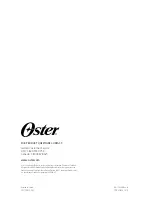
5-4
TROUBLESHOOTING
ORBAN MODEL 8382
an input problem. If it only appears at the analog output, then it is likely a problem
with the left/right DACs or other analog circuitry.
Another possible cause is oscillation in the analog input or output circuitry. A whistle
could also be caused by power supply oscillation, STL problems, or exciter problems.
Any competent BTSC stereo encoder will have very effective 15 kHz lowpass filters at
its input, so ultrasonic spurs are unlikely to cause problems unless the stereo genera-
tor itself is faulty.
Interference from stereo into subcarriers
Clipping of the composite baseband in the BTSC and EIAJ systems can cause such in-
terference. Such composite clipping result from your over-driving a composite link
between your BTSC or EIAJ stereo generator’s composite output and the exciter's
input.
If the exciter is non-linear, this can cause crosstalk. In general, a properly operating
exciter should have less than 0.1% THD at high frequencies to achieve correct opera-
tion with subcarriers.
To prevent truncation of the higher-order Bessel sidebands of the FM modulation,
the RF system following the exciter must be wideband (better than
±
500kHz) and
must have symmetrical group delay around the carrier frequency. An incorrectly
tuned transmitter can exhibit an asymmetrical passband that will greatly increase
crosstalk into subcarriers.
Amplitude modulation of the carrier that is synchronous with the program (“syn-
chronous AM”) can cause program-related crosstalk into subcarriers. Synchronous
AM should be better than 35dB below 100% modulation as measured on a synchro-
nous AM detector with standard de-emphasis (50 µs or 75 µs).
The subcarrier receiver itself must receive a multipath-free signal, and must have a
wide and symmetrical IF passband and a linear, low-distortion FM demodulator to
prevent program-related crosstalk into subcarriers.
Shrill, Harsh Sound
This problem can be caused by excessive HF boost in the HF Equalizer and HF Enhan-
cer. It could also be caused by an excessively high setting of the
BAND
4
THRESH
control (if you are using the Five-Band Structure), or by excessively high settings of
the
BAND
4
MIX
and
BAND
5
MIX
controls (located in Full and Advanced Modify).
If you are driving an external stereo encoder with built-in pre-emphasis, you must
set the 8382’s output to Flat in the System Setup / Output screen to prevent double
pre-emphasis, which will cause very shrill sound (and very poor peak modulation
control).
Dull Sound
If you are using the Two-Band structure, dull-sounding source material will sound
dull on the air. The Multiband structure will automatically re-equalize such dull-
sounding program material to make its spectral balance more consistent with other
program material.
Содержание Optimod-TV 8382
Страница 22: ......
Страница 108: ......
Страница 162: ......
Страница 174: ......
Страница 213: ...OPTIMOD TV DIGITAL TECHNICAL DATA 6 25...
Страница 214: ...6 26 TECHNICAL DATA ORBAN MODEL 8382 Base Board Parts Locator Drawing for schematic 62165 000 06...
Страница 219: ...OPTIMOD TV DIGITAL TECHNICAL DATA 6 31 CPU Module...
Страница 225: ...OPTIMOD TV DIGITAL TECHNICAL DATA 6 37 RS232 BOARD PARTS LOCATOR...
Страница 227: ...OPTIMOD TV DIGITAL TECHNICAL DATA 6 39 POWER SUPPLY PARTS LOCATOR...
Страница 229: ...OPTIMOD TV DIGITAL TECHNICAL DATA 6 41 8382 I O Board Parts Locator...
Страница 234: ...6 46 TECHNICAL DATA ORBAN MODEL 8382 DSP BOARD PARTS LOCATOR DRAWING 32170 000 14...
Страница 242: ...6 54 TECHNICAL DATA ORBAN MODEL 8382 DISPLAY BOARD PARTS LOCATOR...
Страница 243: ...OPTIMOD TV DIGITAL TECHNICAL DATA 6 55 DISPLAY BOARD...
Страница 244: ...6 56 TECHNICAL DATA ORBAN MODEL 8382...
















































